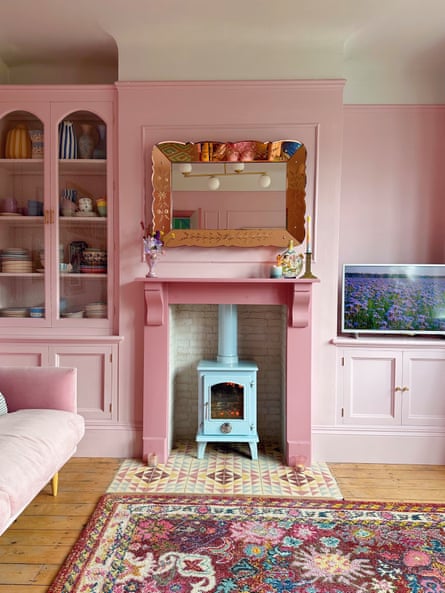When Jess and Rick Sowerby started searching for their first home in 2018, they had not considered a fixer-upper. But after 30 viewings without finding their dream home, it was time for a change of plan.
“I was getting disheartened – I thought we’d never find anything,” says Jess, 33. “Some houses were lovely but weren’t to our taste. I’d have felt guilty ripping out a new kitchen or bathroom just because we didn’t like it, so we decided to buy a home that actually needed the work done.”
Renovation projects were about £90,000 cheaper than “turnkey” homes (those that are finished and ready to move into), giving the Sowerbys more budget for the project. In February 2019 they got the keys to their 1930s semi-detached house on a cul-de-sac in Rochdale, Greater Manchester, and got to work.
“It had been empty for six months and was cold, damp, dated and musty. But it felt like a home,” says Jess, who has documented their renovation on the Instagram page The House that Colour Built.

As house prices continue rising, many buyers are looking to renovation projects as a cost-effective way of getting on the ladder. The average first-time buyer home cost £229,094 in August this year, according to the estate agency Hamptons, which analysed Land Registry data. It was £156,453 in August 2015.
However, fixer-uppers can go for considerably less than the average.
About 7% of the properties listed on the property website Zoopla are fixer-uppers. Wales, south-east England and Yorkshire and the Humber are the regions with the most properties falling into this category, and two- and three-bedroom houses are the most common renovation projects on the portal.
Lack of choice in their area is another reason why some opt for a property that needs work.
Steve Lees, from the Royal Institution of Chartered Surveyors (Rics), says: “Doer-uppers are a real opportunity to do a deep retrofit, and you can really add value if you improve the property’s energy efficiency rating.
“Ultimately, it’s the chance to make your home your own.”
Where to start
There are various things to consider when you are starting on this journey and checking out potential properties.
Lees says you should research the local area and amenities. Consider things such as transport links, crime rates and schools, just as you would for any home purchase. And look at previous transaction prices for similar properties nearby.
Next, consider the structure. “Look around internally and externally. Use all of your senses,” he says.
“Look for obvious defects: cracks in the walls, the roof, signs of damp. Is there anything that would stop you getting a mortgage? Some lenders won’t accept certain construction types.”
For any property requiring major work, it is worth getting a structural survey done. This will identify any potential issues and help you formulate a budget and timeline for the renovation.

When looking at properties, focus on the layout and flow, says Jess Sowerby. And consider elements that will be difficult or more expensive to change, such as walls and windows.
“Remind yourself that the disgusting wallpaper, awful carpet and paint colours are not permanent,” she says. “It’s about the bones of the house – the things that are going to matter.”
The Sowerbys’ house needed a full rewire; it had damp, and all of the walls required skimming or replastering. The carpets needed replacing; the wallpaper was peeling off; and the original doors and staircase had been boarded over so needed stripping, sanding and filling.
An extension was their biggest cost at about £35,000, including three large skylights and bifold doors. They also spent £2,500 on a new front door and surrounding windows, and £6,000 on the rewire.
But not all jobs require such a big outlay. Painting and decorating are some of the easiest and cheapest ways to put your stamp on a home. Zoopla says it costs about £2,495 to decorate a house, and just over £3,500 for a simple garden revamp.
To add value, restore period features – particularly if the property is more than 100 years old. The find-a-tradesperson website Checkatrade estimates that restoring doors, floors and fireplaces can add up to 30% to the value.
An extension isn’t cheap, but the extra space will definitely add value. A single-storey extension can add 5%-8% to a house’s value, says Checkatrade, and a loft conversion 20%. Meanwhile, installing solar panels can reduce your energy bills as well as adding value – up to 14%, according to the site.
Jess and Rick Sowerby, who rented a house nearby while they did the work, used YouTube videos and Instagram to learn new skills. If you have a tradesperson on site, shadow them, or ask a local building merchant for advice.
Doing a good chunk, or all, of the work yourself can cut costs, but expect things to take longer. Jess and Rick did quite a bit of the work themselves and used tradespeople for the electrics, plumbing and the extension.
“It [going down the DIY route] saved us about £15,000, but I wish I’d known how long it was going to take. I assumed about six months, but that was naive,” says Jess.
Have a backup plan
Every budget needs a contingency. Lees recommends factoring in an extra 15%-20% for the unexpected.
Chris Husson-Martin, at the Salisbury branch of the estate agent Hamptons, says: “Unexpected issues invariably arise, particularly with elements that aren’t immediately visible, like electrics or drainage.
“One client discovered a well beneath their kitchen tiles. They ultimately transformed it into a stunning feature, but such surprises can significantly impact budgets and timelines if you’re unprepared.”
The biggest unexpected cost for the Sowerbys was £5,000 to install piling for their extension after they were advised that not doing so could result in subsidence. Piling is the process of building a type of deep foundation where, typically, columns made of steel or concrete are bored or driven into the ground.

You should check whether you can get help with the costs, says Husson-Martin. “Various government grants and loans are available for renovations such as insulation and heating system upgrades.”
Some councils offer empty home grants to homebuyers and landlords to help with renovating a property that has been unoccupied long-term, though the amounts and eligibility criteria vary, so check with your local authority.
And some buyers may want to consider a green mortgage: some lenders offer a lower interest rate or cashback where energy efficiency upgrades are being carried out.
Living offsite means you can escape the dust, but it comes with extra costs. You may have to rent somewhere nearby while the work is being done, and also pay for things such as temporary storage of possessions. Home insurance may be more expensive for an unoccupied property.
After 15 months of hard graft, the Sowerbys moved into their home in May 2020. The couple, now parents to one-year-old Guy, bought the house for £155,000 and spent £50,000 on their renovation. In August, their home was valued at £350,000.
“It’s good to know our hard work was worth it,” says Jess. “But we’re not planning to move. If you’ve put your heart and soul into something, why would you sell it? I’m too sentimental.”
Three jobs that could cost you
The roof “A damaged roof can lead to damp, mould and poor energy efficiency, but it’s often hard to spot,” says Alex Peters, of Checkatrade. Check exterior tiles and look in the loft for cracks or water damage. A roof inspection costs about £250, and a drone survey about £200.
Asbestos A commonly used material until the 1970s, asbestos can only be safely removed by professionals, so stop work immediately if you suspect its presence. Be wary of vinyl or lino floor tiles, old electrics or insulation. An asbestos survey costs from £200 to £1,000, and removal will typically cost anything from £950 to £3,750.
Structural damage Before choosing paint colours, check the structural integrity of the property. “Identify load-bearing walls and address any cracks, water damage or foundation issues before starting any other projects, as these may affect your overall plans,” says Peters.
Renovation maths
Average costs for common jobs, according to Checkatrade:
-
New central heating system Average cost of installing a gas system: £5,250 including labour.
-
Rewiring the electrics An average of £6,225 plus VAT for a three-bed house (includes labour), or £4,800 plus VAT for a two-bed flat (includes labour).
-
Knocking down walls Cost to remove a load-bearing wall: £3,300 plus VAT (includes labour), based on a project cost of £1,500 and three days’ labour.
-
Damp proofing Difficult to give an average as there are many variables. However, the cost of a full damp proofing course could typically come in at £5,000.
-
Replastering walls One small room: about £1,400 plus VAT (includes a day’s labour). A larger room: about £2,500 plus VAT (includes three days’ labour).
-
Installing double glazed windows For a basic casement window, the price starts at £500 and averages at £1,000. Plus £250-£300 a day for each double glazing installer.
-
Roof repair £110 to £160 a sq metre for plain tile on a pitched roof (this varies depending on the type of roof and material). Labour will be on top and will depend on the size of area.
-
Removing asbestos Between £950 and £3,750 – this is for asbestos roof removal. This is labour costs – skip hire and so on is likely to be extra.
Source: Checkatrade

.png) 16 hours ago
10
16 hours ago
10

















































